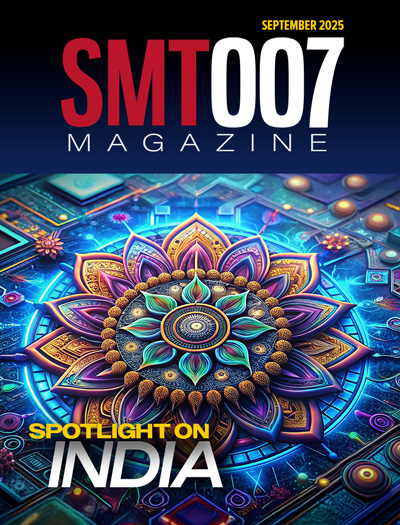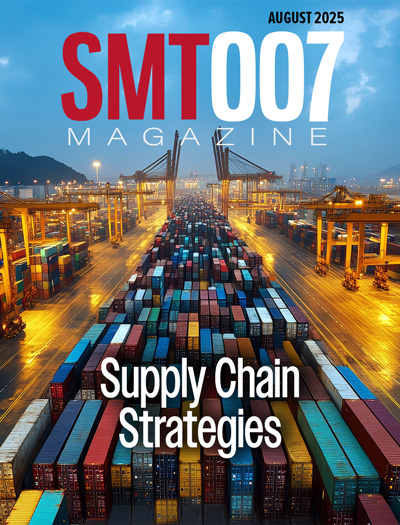-

- News
- Books
Featured Books
- smt007 Magazine
Latest Issues
Current Issue
Spotlight on India
We invite you on a virtual tour of India’s thriving ecosystem, guided by the Global Electronics Association’s India office staff, who share their insights into the region’s growth and opportunities.

Supply Chain Strategies
A successful brand is built on strong customer relationships—anchored by a well-orchestrated supply chain at its core. This month, we look at how managing your supply chain directly influences customer perception.

What's Your Sweet Spot?
Are you in a niche that’s growing or shrinking? Is it time to reassess and refocus? We spotlight companies thriving by redefining or reinforcing their niche. What are their insights?
- Articles
- Columns
- Links
- Media kit
||| MENU - smt007 Magazine
Build Better 2024 Summit: Creating a Vision for Future Tech
October 18, 2024 | Marcy LaRont, I-Connect007Estimated reading time: 4 minutes
The morning portion kicked off with “The Apple Way, the Motorola Way and the Next Way,” which was described as, “There are lots of ‘ways’ to do electronics NPI and manufacturing. Motorola gave us EVT, DVT, and PVT and Apple gave us execution at scale. What are the core lessons of these methodologies and how are modern organizations honoring or breaking them?” An interesting panel discussion ensued with Zach Scott, head of hardware at Backbone, Matt Hill, senior of device engineering at Snap Inc., and Felix Alvarez, manager of Second Order Effects. Their words were simple but wise: Learn from history but don’t be limited by it; the key to success is continuous, deep learning throughout your career; and (my personal favorite) don’t play by the rules that others have set out for you. Don’t be afraid to take a chance.
In another presentation, Sapana Talwaker, VP of hardware operations at Toast, spoke about scaling manufacturing, and was asked how she defines operational excellence. She responded that operational excellence occurs when operations are closely aligned with the organization’s objectives, when continuous improvement is built into the system, and when it can react and adapt as needed. She cited adaptability as perhaps the single most important characteristic for operational excellence in “the next way.” Toast is a POS platform, which is largely a software product. Talwaker underscored the importance of hardware in a software-focused world, “Hardware is an enabler product for Toast,” she said. Being out of stock is not an option, as it means missing out on much greater revenue opportunities. The two are inextricably linked. One simply does not work without the other—hinting at our industry’s own, “silicon to systems” approach to discussing chips and packaging.
Valentina Ratner, co-founder of AllSpice.io, a collaborative platform for engineers developing new products, gave a presentation on a survey titled “The State of Hardware 2025: 1,000 Engineers on Trends, Challenges, and Toolsets,” which provided data about the things we were pretty sure we already knew.
The greatest challenge for engineers over the past year has been shrinking product development cycles and deadlines. They have spent too many hours a week troubleshooting problems, although it’s probably the most helpful skill making someone a more efficient and effective engineer. In both the latter scenarios, it was pointed out how specific software tools can add tremendous value. Interestingly, they cited the feeling that only 25% of software, hardware, PCB, and firmware companies collaborate effectively. I also found it interesting, especially in view of ever-shrinking product development cycle times, was that 48% of the 1,000 engineers surveyed said they did between three to five iterations per product prior to release. From the conference, it was clear that hardware manufacturing is changing and the integration of high-level software tools that incorporate sophisticated AI functionality will be a very significant part of “the next way” for manufacturing. This is not groundbreaking knowledge for sure, but it is always interesting to see how the varied electronics industry is taking the same language and headed in the same overall direction.
Testimonial
"Our marketing partnership with I-Connect007 is already delivering. Just a day after our press release went live, we received a direct inquiry about our updated products!"
Rachael Temple - AlltematedSuggested Items
HyRel Technologies Showcases Summer Intern Success Through Hands-On Innovation
09/16/2025 | HyRel TechnologiesHyRel Technologies, a global provider of quick turn semiconductor modification solutions, proudly highlights the accomplishments of its two recent summer interns, Danny Hoang and Nisarg Jadav.
ICAPE Group Unveils Exclusive Report on Sustainability in Electronics Manufacturing
09/15/2025 | ICAPE GroupICAPE Group, a global leader in printed circuit boards (PCBs) and custom electronics manufacturing, today announces the launch of its 2025 Industry Outlook & Innovation Report: Sustainability in Electronics Manufacturing. This exclusive report is accompanied by fresh insights from a dedicated Statista survey of 100 electronics manufacturing professionals, commissioned by ICAPE Group.
I-Connect007 Editor’s Choice: Five Must-Reads for the Week
09/12/2025 | Marcy LaRont, I-Connect007We may be post-Labor Day, but it is still hot-hot-hot here in the great state of Arizona—much like our news cycles, which have continued to snap, crackle, and pop with eye-raising headlines over this past week. In broader global tech news this week, AI and tariff-type restrictions continues to dominate with NVIDIA raising its voice against U.S. lawmakers pushing chip restrictions, ASML investing in a Dutch AI start-up company to the tune of $1.5 billion, and the UAE joining the ranks of the U.S. and China in embracing “open source” with their technology in hopes of accelerating their AI position.
Machvision Leads Shift to Automated Inline Final Inspection, AOI in North America
09/10/2025 | Ralph Jacobo, all4-PCBSchweitzer Engineering Laboratories (SEL) chose Machvision inspection equipment due to its capabilities and versatility. Machvision of Taiwan offers circuit inspection, hole inspection and measurement, IC Substrate and HDI inspection, and final visual inspection solutions. The best fit for SEL was the 4.0Pro Circuit Inspection for inner and outer layers, and the AFI6 for final visual inspection of finished panels.
Dan Feinberg on Walt Custer: Remembering an Extraordinary Business Associate and Friend
09/09/2025 | Dan Feinberg, Technology Editor, I-Connect007The passing of Walt Custer marks the end of an era for all those who knew him and were helped and impressed by his presence, both personally and professionally. Walt's life was characterized by his unwavering commitment to the industry, his profound wisdom and willingness to share it, and his infectious enthusiasm for everything he did.


